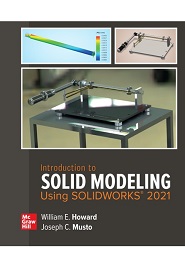
English | 2021 | ISBN: 978-1265242633 | 288 Pages | EPUB | 30 MB
As design engineers and engineering professors, the authors have witnessed incredible changes in the way that products are designed and manufactured. One of the biggest changes over the past 30 years has been the development and widespread usage of solid modeling software. When we first saw solid modeling, it was used only by large companies. The cost of the software and the powerful computer workstations required to run it, along with the complexity of using the software, limited its use. As the cost of computing hardware dropped, solid modeling software was developed for personal computers. In 1995, the SOLIDWORKS® Corporation released the initial version of SOLIDWORKS® software, the first solid modeling program written for the Microsoft Windows operating system. Since then, the use of solid modeling has become an indispensable tool for almost any company, large or small, that designs a product.
While 2-D drawings can be an effective tool to document and communicate design details, a solid model’s usefulness extends throughout the design process. The solid model data can be saved in a format from which a physical model can be made with a 3-D printer. Structural, thermal, dynamic, and fluid flow analysis can be performed with finite element analysis (FEA) and other simulation software. Photorealistic pictures, including materials, textures, lighting, and backgrounds can be created to allow complete visualization of designs before they exist. The image on the cover shows a laboratory test fixture designed for torsion testing of shafts in a college laboratory. The test fixture, designed by Dr. Mohammad Mahinfalah at Milwaukee School of Engineering, allows students to apply torque to one end of a machine shaft with a torque wrench, and measure the resulting twist in the shaft. This demonstrates theory learned by students in their mechanics of materials courses. The test fixture was designed using SOLIDWORKS, and the SOLIDWORKS assembly model of the test fixture is shown on the cover. A simulation of the machine shaft was performed using SOLIDWORKS Simulation to see how the fixture would operate, and the resulting simulated test is also shown on the cover. The final assembly model was then rendered using the SOLIDWORKS PhotoView 360 tool. The cover image showing the test fixture in a laboratory setting is not a photograph, but the photorealistic image created with the software. This visualization tool allows the designer and customers to see the product as it will appear in use before it is manufactured.
HomepageResolve the captcha to access the links!